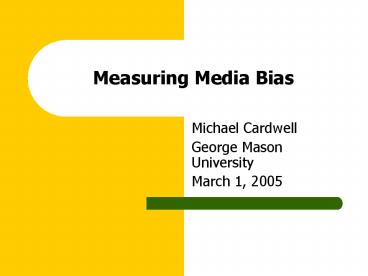Measuring Media Bias PowerPoint PPT Presentation
1 / 21
Title: Measuring Media Bias
1
Measuring Media Bias
- Michael Cardwell
- George Mason University
- March 1, 2005
2
Overview
- These are headlines from March 10 and 11 2004
regarding the case of Susan Lindaurer who was
accused of illegally taking payments to lobby for
Iraq. All are true, yet they shed different
light on the situation - Washington Post Md. Activist Charged With
Working for Iraq Indictment Says Ex-Press Aide
Had Intelligence Links to Hussein - NY Times Former U.S. Aide Accused of Working
With Iraq - Seattle Post-Intelligencer Accused spy is cousin
of Bush staffer - Wiz Bang Blog Democratic Staffer Indicted For
Spying For Iraq - Is this media Bias at work?
3
Overview
- Headlines regarding a single event can be
factually true yet lead readers down different
ideological and political paths - Is the news media biased? Conventional wisdom
and scholarly evidence often suggests it is, but
compared to what? - Lott and Hasslett (2004) Disparate reporting on
similar events. - Groseclose and Milyo (2003) Reporting ideology
does not reflect political ideology
4
Theory
- Media bias matters because we require political
information to make political decisions. - In light of this requirement, systematic bias
from journalists is suggests we receive
misleading information with which to make
decisions
5
Theory
- A public interest approach (a la the Society of
Professional Journalists) suggests an ethical
solution. Journalists morally bound not to
distort or misrepresent facts - A public choice approach.
- (Need not be mutually exclusive to public
interest approach). - Examine institutional constraints and
opportunities for biased journalism
6
Theory
- Bovitz et al (2002) demonstrate conditions under
which leading can occur - Leading media presents an ideologically
distorted report that shifts reader opinion - Bias a report that is ideologically at odds with
a given point of reference.
7
Theory
- Groseclose and Milyo demonstrate method of
observing bias using ADA Ratings - ADA Ratings are 0-100 scores based on correct
answers (5 points each) to 20 legislative
questions. - Identify ADA Ratings for Congress
- Identify ADA Ratings for media outlets
- Observe media outlets are well to the left of
Congress - Hence, it is at least feasible that leading
occurs if bias is observed. If no bias is
observed at all, leading is either not happening
or VERY efficient.
8
Methodology
- Starting point is Groseclose and Milyo approach
to measuring bias, but with significant changes - Essential features
- Measures bias as difference between Newspaper ADA
rating (based on editorial position) and House of
Representatives ADA ratings - In Aggregate for all major newspapers
- For Designated Market Areas (DMAs)
- New York
- Washington DC
- For 2001-2002 (107th Congress)
9
Methodology
- Starting point is Groseclose and Milyo approach
to measuring bias, but with significant changes - ADA ratings calculated directly from newspaper
editorials - Bias, if it exists, is likely to reflect official
editorial positions - Easier to do, generally less interpretive than
passive analysis
10
Methodology
- Intuition is that market area is important. New
York Times largely sold in New York. - Market area, not national aggregate, is proper
area for determining bias. - DMAs are industry standard geographic
categorization for newspaper markets. - Circulation of major papers used to develop
weighted average news outlet ADA score. - Population and Congressional ADA ratings used to
develop weighted average political outlet ADA
score.
11
Results National ADA
12
Results District ADA
13
Results DMA ADA
14
Results Aggregate ADA
15
Results - Analysis
- In the measured markets, observed newspaper
ideology is similar to observed political
ideology. - Market sample, however, is limited and liberal.
- Does not consider competition from other media
types (e.g. radio, internet)
16
Conclusions Consumers Lead the Market
- Lack of observed bias implies leading by media is
either very effective or not very effective at
all - I suggest the latter is the case
- Perfect leading by numerous independent media
outlets, simultaneously resulting in an aggregate
similar to the political market outcome seems
unlikely - An unbiased aggregate ideology that emerges
because consumers of political information desire
it and also vote appears more likely - Hence, the market responds to a desire for
ideology, it rather than impose it.
17
Conclusions A Happy Result?
- Is it an unsatisfying result to conclude
- Consumers demand political information tailored
to ideological whim, rather than purely
objective? - Unbiased results exist in the aggregate, but all
individuals and firms may be biased? - Perhaps, but it appears to be an example of
spontaneous order, but we also desire individuals
who can view opposing perspectives
sympathetically - Several limits exist which limit the extent to
which ideology can dominate
18
Conclusions Consumer limits
- Tullock Consumers of media buy a package of
goods - Desire information
- But also entertainment
- Purpose is not just to vote, but to converse
- Suggests consumers will forego some ideological
purity to gain - Non political information (e.g. Sports Page)
- Opposing political information (know your enemy)
19
Conclusions Market Forces
- Producers are not oblivious to consumer needs.
They may trade-off on the ideology-content access
as well. - Observation Market concentration may promote
moderation (note moderation is not necessarily
good) - Unlike Congressmen, Newspapers can avoid the
really hot topics
20
Conclusions Issue Avoidance and Contestability
21
Conclusions Issue Avoidance and Contestability
- Newspapers do not take an overt stand on issues
that may cost them profits. - And finally, interpretations of facts can be
inherently contestable and open to interpretation
as in opening example. - These factors, along with consumer desire for
some opposition view, seem to set limits to the
extent to which papers are slaves to consumer
ideology and the fact widespread bias is not
observed implies neither is the opposite the case.

